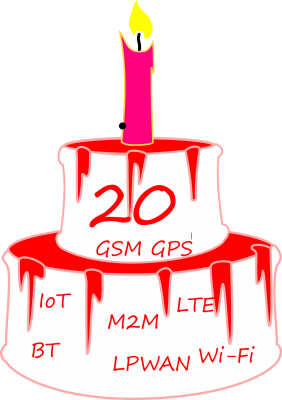Before the year comes to an end there is a need for a birthday cake on my desk. This is because I have been working in GSM and GPS for 20 years.
What has happened in those 20 years?
GPS
- GPS have modules achieved lower and lower power consumption. Today we are at 5 mA at Full Tracking (no Power Save Mode active)
- GPS has been extended to Glonass (for Galileo, we are still waiting)
- GPS modules have been getting smaller
- GPS modules now support free A-GPS
- GPS modules today have an integrated data logger
- GPS modules are becoming cheaper
Many GPS modules still list 21 mA to 35 mA in the data sheet. 5 mA at Full tracking is already more than 80 % lower than other modules in the GPS market. Let’s see what will happen in the next 20 years. Perhaps Europe will have to be Galileo. 😉
GSM
- GSM modules were getting lower and lower in power consumption. We are today at 1 mA in Idle Mode (still able to receive a call or SMS )
- GSM has been extended to GPRS and EDGE
- GSM modules have been getting smaller
- GSM modules now support free locating on cell tower triangulation
- GSM modules today have an integrated Real Time Operating system to run on code
- GSM modules are becoming cheaper
20 years ago the power consumption was 20 mA. A while later we moved to 5 mA. Today we reached estimated 1 mA. The current peaks have shrunk from 2,5 Ampere to 1,8 Ampere. The end result is a much longer standby time on battery than two decades ago. GSM / GPS trackers profit from the lower power consumption in both wireless technologies. They have become smaller and smaller and the standby time is much longer today.
Myself
- I got 20 years older
- I was involved in a lot of cellular projects and for some reason a lot of projects were in the tracking of something
- I had an idea for tracking without GPS on GSM base stations, the idea beccame real and the patent was sold
- I started to collect planar cellular PCB antennas in 2004 and one shape is listed in my book (the public simulation has a value of 3500 Euro)
- I started to write the IoT M2M Cookbook in May 2012 and finished it in summer 2014
The finished IoT M2M Cookbook is a living work, because I plan to offer updates. Some updates are triggered by consulting projects; other updates are triggered by questions from readers or customers of wireless modules and antennas. The third reason for updates is LTE. In US we will get a sunset of GSM. AT&T will go ahead with UMTS (HSPA/WCDMA) only. In Europe Swisscom in Switzerland will sunset GSM and replace it with LTE and UMTS. LTE has already a chapter in my book. However, in summer 2014 there were not a lot of details about LTE-M, LTE-MTC, NB-LTE and further LTE topics in the public domain. It is still not clear which cellular operator will install which LTE technology. LTE is a patchwork of more than 40 frequency bands across the world and no LTE module will be able to cover all bands. We will have LTE modules with selected bands for regions.
Moreover NB-LTE and several LPWAN technologies are addressing the same market.
The Future
- Remember the good old time on GSM quad band and its easy cheap integration worldwide
- Focus on LTE and LPWAN, because both are addressing the wireless wide area networks necessary for IoT
- Updates on LTE, GNSS, LPWAN for my first IoT M2M Cookbook
- I will start the next IoT M2M Cookbook
- I will also be writing recipes for the IoT cook
As long as I write cookbooks, recipes and consulting I do not plan to retire. I love to share my knowledge and experience and I am always glad if some electronic engineers with no or less experience in radios and antennas move within a few months from an idea to a prototype and later on to mass production.
And if you have a need for wireless modules, antennas, consulting or development for your IoT M2M application, then to not hesitate to drop an email to harald.naumann (at) gsm-modem.de. I will be glad to support your IoT M2M project as well. Thank you in advance for any request or order for the IoT M2M Cookbook.

Hi Harald,
You mentioned above that “5 mA at Full tracking is already more than 80 % lower than other modules in the GPS market”.
Is this true that some GPS module takes just 5 mA at full tracking? I have not come across such a module yet or am I reading your statement incorrectly?
If you know of such module currently in the market then please let me know.
Thanks,
Sunil
Hi Sunil, yes it will charge 5 mA only. Just test it yourself. I will come back to you by email.
Regards
Harald